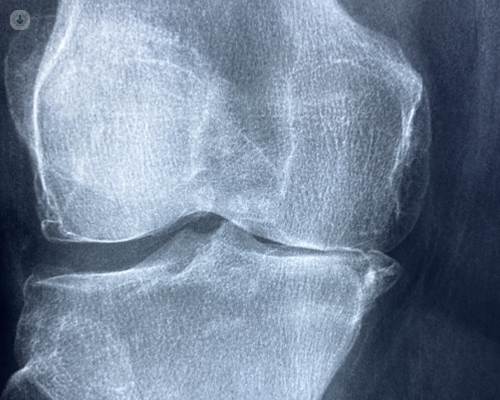Unicompartmental knee replacement: Suitable candidate, benefits, risks and more
Autore:The medial unicompartmental knee replacement, or partial knee replacement, is a surgical solution for isolated medial unicompartmental osteoarthritis, and while it has various benefits there is specific criteria patients need to meet before the procedure goes ahead.
Here to address this, and other frequently-asked questions about this procedure – particularly how it compares to total knee replacement - is leading consultant trauma and orthopaedic surgeon Mr Ben Spiegelberg.

Who is a good candidate for medial unicompartmental knee replacement surgery?
It can be someone of any age, and someone who fits the criteria for the unicompartmental knee replacement.
That being, they have to have isolated medial compartment arthritis so, no arthritis affecting the other compartments of the knee. This being the lateral compartment and the patellar femoral joint. They have to have an intact interior cruciate ligament, and no evidence of any inflammatory arthropathy; that being rheumatoid arthritis or some systemic arthritis that's likely to mean they're more likely to develop arthritic changes in other parts of the knee.
So, if we do a medial unicompartmental knee replacement they're more likely to need a total knee replacement sooner.
Those are the main criteria. When it comes to assessing a patient, obviously the history they've got significant pain and of exhaustive non-operative treatment. That being;
- physiotherapy;
- injections with steroid and local anaesthetic, or;
- hyaluronic acid injections.
If those non-operative treatment options have failed, and a patient has isolated pain to the medial side of the knee, intact ACL on examination, and no evidence of any inflammatory arthropathy, then they'd be very good candidates for a unicompartmental knee replacement.
What are the benefits and risks of unicompartmental knee replacement compared to total knee replacement?
The benefits of a medial unicompartmental knee replacement are very significant. I'm a really big believer in the medial unicompartmental knee replacement as a procedure because it really does provide significant improvement in patient's knee function, and patient satisfaction scores after the surgery.
Patients tend to have improved range of motion compared to a total knee replacement and the other significant advantage, and reason why I believe there are better patient satisfaction scores and function scores is that with the medial unicompartmental knee replacement, the ACL doesn't need to be sacrificed.
In a total knee replacement, it's required to remove the cruciate ligaments. Within those cruciate ligaments, there are lots of proprioceptive nerve fibres so giving lots of feedback to the brain about the position of the knee, the tension on the knee and all that feedback is lost with a total knee replacement.
Maintaining those cruciate ligaments in a partial knee replacement really provides the patient with a much better chance of having a knee that feels like their old knee. The chance of having a knee that they forget they've had it replaced. Whereas with a total knee replacement, it can often feel a little bit mechanical and you avoid that with a partial knee replacement. Those are the benefits of the partial knee replacement.
The risks are the same risks as that for a total knee replacement, in broad, generic terms. That's risk of infection and we give antibiotics at the time of surgery to reduce the risk. There's risk of blood clots; we give blood thinning medications to reduce the risk of blood clots.
There's risk of stiffness, and it's very important that patients work on their physiotherapy afterwards and get the knee moving straightaway. There's less chance of stiffness with a medial unicompartmental knee replacement compared to a total knee replacement. Patients are more likely to achieve ranges of motion in excess of 120 to 130 degrees.
Other risks are:
- risk of fracture, and;
- need for revision surgery.
The only different risks with a partial knee compared to a total knee, is that there's a risk of progression of arthritis, whereby the other parts of the knee can develop arthritis later on and require revision surgery if they become symptomatic. The risk of progression of arthritis is about ten per cent of patients at ten years, developing progressional arthritis that requires revision.
What can I expect during and after the unicompartmental knee replacement procedure?
You come in for surgery, have the operation done - some patients can have the surgery done as a day-case procedure. Most patients are going home on day one or day two post-operatively. That's having passed physio, which will involve walking and having been able to go up and down the stairs.
Generally, patients start off walking with crutches, although some patients can mobilise full weight-bearing on the knee replacement from the get go. It isn't a pre-requisite, it's just that it can be a bit painful and patients prefer to have crutches to support themselves.
Patients require relatively strong painkillers for the first week or two after surgery. Then it tails off fairly rapidly. Generally, patients, by four to six weeks after the operation are in a position where they're better than what they were before the operation.
By that, I mean they're noticing they're now getting an improved range of motion from what they would have been pre-operatively and also starting to mobilise better than what they were preoperatively. They're likely to have come off their stronger painkillers, onto more regular painkillers. Indeed, a lot of patients may be off painkillers completely by that stage.
What complications can arise from unicompartmental knee replacement, and how can they be managed?
Most complications are fairly similar to that of the total knee replacement. There's a risk of infection, which is around 0.5 per cent. We give antibiotics at the time of surgery to reduce the risk. Obviously, we undertake a meticulous surgical technique to further reduce the risk as well. There's risk of blood clots in the region of about 2 per cent, with use of blood-thinning medication to reduce the risk of blood clots.
Stiffness can develop, but generally patients who do the physio work don't develop stiffness after a partial knee replacement. It's more common with total knee replacements.
A fracture can occur but that is rare.
There's a risk of actual progression of arthritis, so where the other unreplaced parts of the joint, either the lateral part of the joint or the patellar femoral joint, can become symptomatic with arthritis at a later date. There's a risk of ten per cent of patients developing progression of arthritis that requires revision. The risk rate for that is pretty low.
A knee replacement is a mechanical joint so it does wear out and can loosen. The life expectancy of a partial knee replacement is about 15 to 20 years; after which, it can wear out and require revision surgery.
Those are the main risks and complications. There's generally a solution for them and like I say, the advantages of the partial knee replacement really do, in the right patient, outweigh the performance of the total knee replacement. I certainly recommend it as a really great solution for isolated medial unicompartmental osteoarthritis.
If you require expert treatment for unicompartmental knee replacement, you can arrange a consultation with Mr Spiegelberg via his Top Doctors profile.


